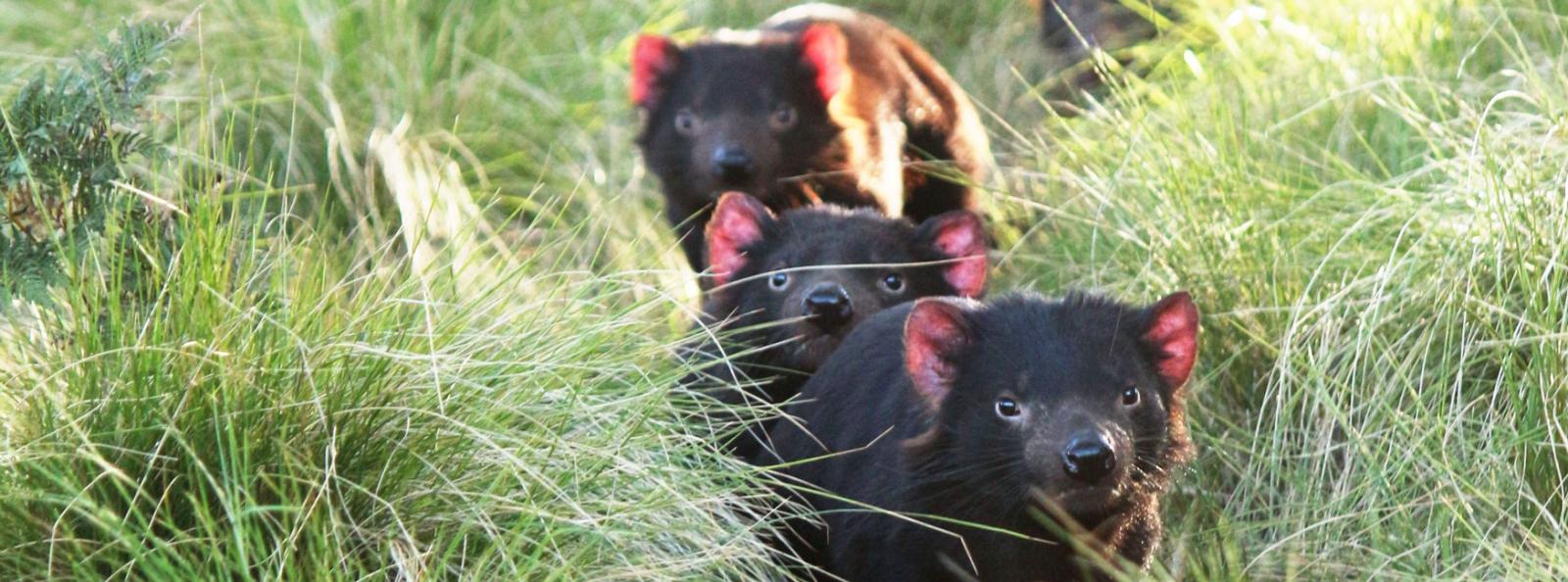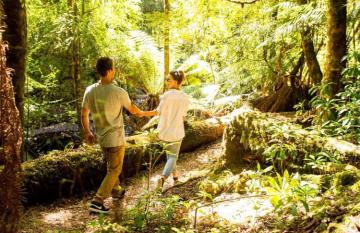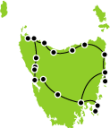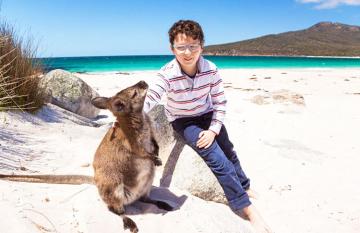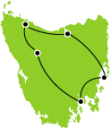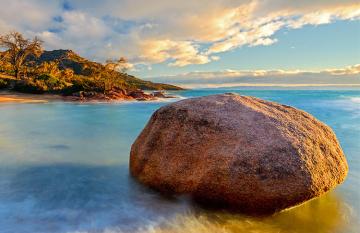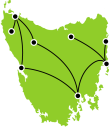
Want to see Tasmania’s famous wildlife up-close? Find everything you need to know about spotting wildlife at Cradle Mountain in this guide.
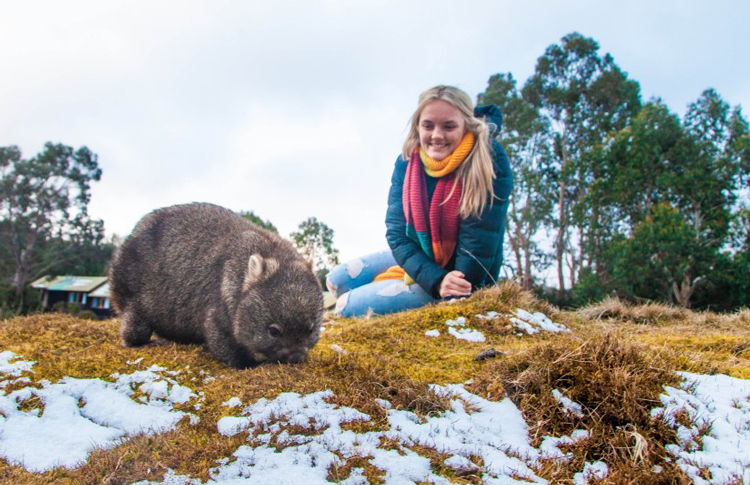
Contents
Tasmania is one of Australia’s most diverse and beautiful regions, and Cradle Mountain is one of Tasmania’s richest and most stunning areas of natural wilderness. It should be no surprise, then, to learn that Cradle Mountain is home to some of Tasmania’s best wildlife-spotting opportunities.
Whether you’re planning a child-friendly family holiday or an active adventure in the wilderness, there are loads of opportunities to take in some wonderful wildlife on any trip to Cradle Mountain.
What wildlife is Cradle Mountain known for?
With its diverse landscapes and different ecological zones, Cradle Mountain is home to a large number of different local wildlife species, both endangered and common. Here are some of the most distinctive and popular to keep an eye out for:
The night-hunters:
Shy and rare Cradle Mountain creatures:
The world’s two largest species of carnivorous marsupials can be seen at Cradle Mountain. Both are surviving remnants of a once-larger group of marsupials, which thrived across Australia before the arrival of European settlers.
Tasmanian Devils
The Tasmanian Devil is surely the wildlife icon of the island state, and it’s well-known even beyond Australia. Growing up to 30 cm in height and 12 kg in weight, the Tasmanian Devil is the world’s largest surviving carnivorous marsupial. They are nocturnal carnivores with incredibly strong jaws and teeth. They come out at night to feed, mostly on carrion, although occasionally by hunting and killing live prey. Their distinctive call – a chilling, guttural, hissing sound – is what inspired their ‘devil’ name for early settlers, although in reality they are harmless to humans.
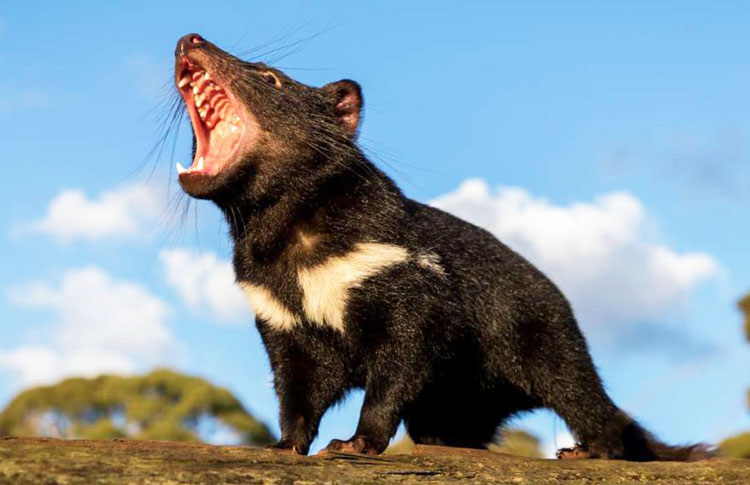
Spotted-tail Quolls
The second-largest carnivorous marsupial on Earth, the Spotted-tail Quoll is one of two quoll species (the other being the Eastern Quoll) that used to be common around both Tasmania and mainland Australia, but are now confined to restricted areas. Compared with the mainland, Spotted-tail Quolls are widely distributed across Tasmania, including at Cradle Mountain. They have distinctive brown-and-white spotted fur, which has somehow (despite tigers having stripes) given them the alternative name of ‘Tiger Quolls’. Spotted-tail quolls start life as pups no larger than a grain of rice, but grow up to 4 kg – and have a lethally strong bite – by the time they reach adulthood!
Nocturnal marsupials
Wombats
If you’re looking for cute- and cuddly-looking creatures, then it’s hard to compete with the lovable, wobbling wombat. Most closely related to koalas, wombats are brown furry mammals that can weigh over 20 kg and grow up to 85 cm in length. They are very powerful diggers and are the world’s largest burrowing mammals, gnawing and digging their way through earth, tree roots and other obstructions to create underground burrows measuring as big as 20 metres across! They are herbivores and love a good lie down, typically spending up to 16 hours a day sleeping before emerging at dusk to graze.
Fun Fact: The wombat’s most distinctive feature is possibly it’s unique, square-shaped droppings. These compact blocks of poo are formed by horizontal ridges in their intestinal system. They help to mark territory for other wombats, since the rectangle droppings won’t roll away like round ones would!
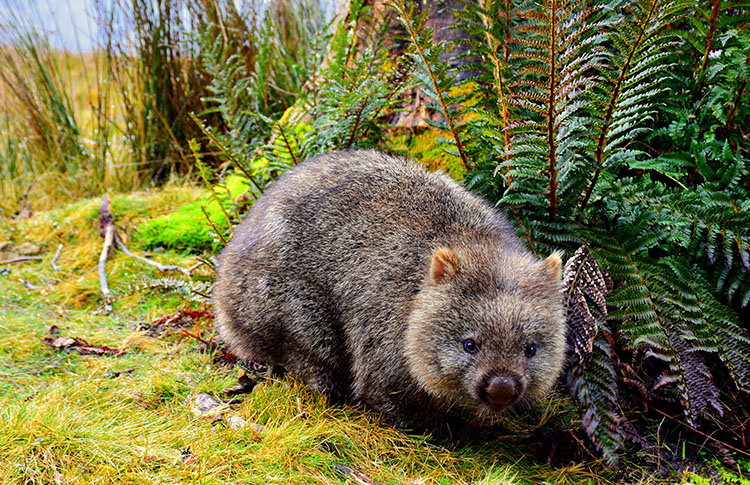
Possums
Mistakenly named by early European settlers for their apparent relationship to South American opossums, Australian possums are in fact much more closely related to kangaroos and other Australian marsupials. The most common species living around Cradle Mountain are the Brushtail Possum (Trichosurus vulpecula) and Ringtail Possum (Pseudocheirus peregrinus). The easiest to see are Brushtail Possums, which nest in trees but come down to the ground to forage at night; whereas the Ringtails tend to spend all their time staying in the trees, feasting on fruit, flowers and leaves, and are more rarely seen around Cradle Mountain.
Hoppy marsupials
The term ‘macropods’ covers the group of Australian marsupials that use their jumpy hind legs to hop around. They are also distinguished by rearing their young in a front-facing pouch. Tasmania’s wilderness, wetlands and forests provide a lush home for a range of these macropods, and at least five different species can be found here. The most common you’ll encounter at Cradle Mountain are the Bennetts Wallaby and the Tasmanian (or rufous-bellied) Pademelon, although the shyer, rarer, Long-nosed Potoroo can also be seen from time to time.
Wallaby
Outside of the kangaroo, wallabies – the name given to Australia’s national rugby team – are the best known and most iconic of Australian macropods. The Bennetts Wallaby (a.k.a. Red-necked Wallaby) is the largest of this local Cradle Mountain group, and they are certainly not afraid of people. You’re highly likely to encounter them whether you’re going deep into the national park on a wilderness hike or merely strolling around the Tourist Information Centre near the park entrance.
Tasmanian Pademelon
Smaller, rounder, chunkier and more furry than their more common cousins, Tasmanian Pademelons look kind of like a cross between the leaner wallaby and the lovable wombat. They are nocturnal, spending most daylight hours resting among thick vegetation before emerging at dusk to roam and feed on the open grasslands. Also very comfortable around people and in healthy numbers all over Cradle Mountain, “paddies” are a common sighting wherever you plan to go.
Long-nosed Potoroo
Much less frequently spotted than their wallaby and pademelon relatives, the quiet, solitary, dirt-digging potoroo is an endangered resident of Cradle Mountain-Lake St Clair National Park. Barely growing more than 30 cm and looking more like a gerbil or a bandicoot than a kangaroo or wallaby, the Long-nosed Potoroo spends a lot of its time hidden among thick scrub and survives mainly on eating fungi, small insects, and seeds scavenged from the undergrowth. Although potoroos are considered relatively ‘common’ in Tasmania compared with the Australian mainland (where they are seriously threatened or endangered), they are still trickier to spot than other wildlife living at Cradle Mountain.
Monotremes (egg-laying mammals)
Two species you can encounter at Cradle Mountain are literally the last of a dying breed: the quirky echidna and the even-more-curious-looking platypus are the only two remaining species of egg-laying mammals in the world. Both can be seen in Cradle Mountain-Lake St Clair National Park, although one is a bit more shy than the other:
Echidnas
Often called ‘spiky anteaters’, Echidnas are curious creatures with a long, beak-like snout, piercing (almost human-like) eyes, and even more piercing spikes protruding from their backs through a thick coat of fur. They are round, ball-like mammals who burrow and rummage in the undergrowth looking for insects. The cutest thing about echidnas may be the name given to their young – “puggles” – who appear at the end of winter, having been hatched directly into their mother’s pouch.
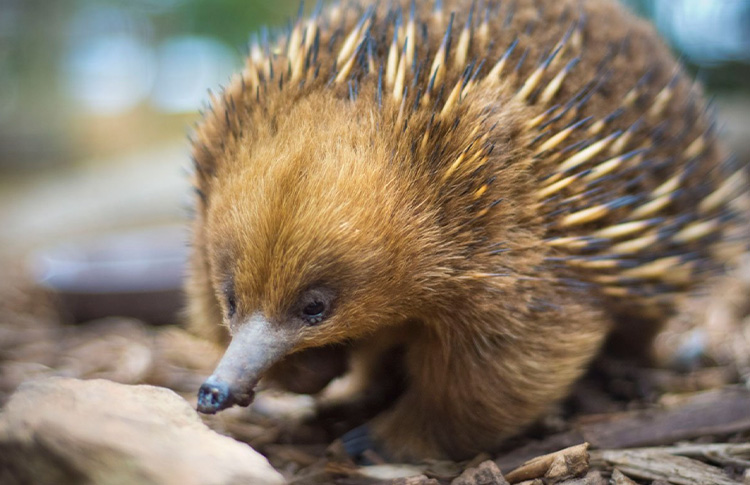
Platypus
One of the oddest yet most familiar of animals in the world, the platypus confused early Europeans by looking like a perfectly balanced combination of a duck (with its bill and webbed feet), a beaver (with its flat tail) and an otter (with its silky fur and body). Platypus are shy, semiaquatic animals who can occasionally be seen near riverbanks in Cradle Mountain around dawn and dusk; although they tend to be less sociable with humans than other Cradle Mountain wildlife. Another intriguing thing about the platypus, harmless as they look, is that they are one of only five venomous mammals in the world, as male platypus have a spur on their hind legs that can release a powerful venom when provoked!
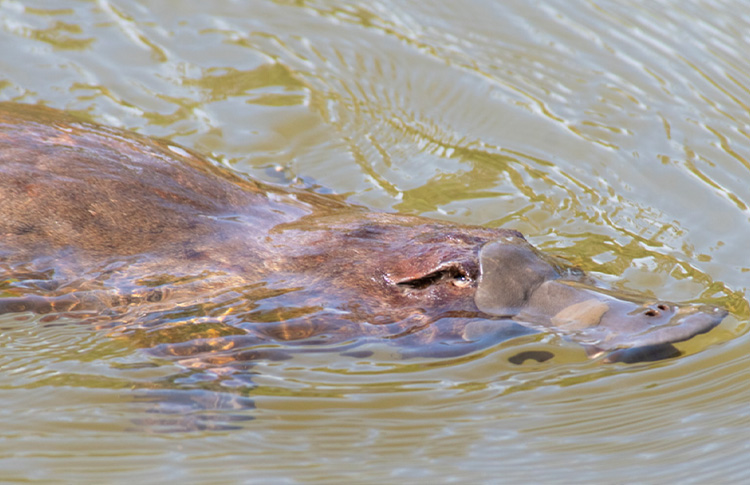
Birds
Cradle Mountain’s lush wilderness is a haven for many bird species, both local and introduced. Among the most popular and exciting birds to see at Cradle Mountain are:
Wedge-tailed Eagle
One of two Tasmanian eagle species found in Cradle Mountain alongside a host of other birds of prey, the impressive Wedge-tailed Eagle are Australia’s biggest raptors. They stand over one metre tall and have a wingspan of over two metres. “Wedgies”, as they are affectionately known, are often spotted riding thermal air currents high in the sky over Cradle Mountain-Lake St Clair National Park. Once you spot their distinctive, wedge-shaped tail in such a state of flight, you’ll see why there’s no prize for guessing where their name comes from.
Black Currawong
These striking endemic Tasmanian birds – almost entirely black, save for specks of white on some wing and tail feathers – can be surprisingly stealthy for their size. They grow up to 50 cm in length, and can often be spotted sneaking food from campers and walkers. However, it’s best not to encourage this or be tempted to feed them, as human treats can wreak havoc on their natural diet and digestive systems. They have a distinctive call, and build nests in forks of trees in the forest canopy. They are probably the most iconic bird of the Tasmanian highlands.
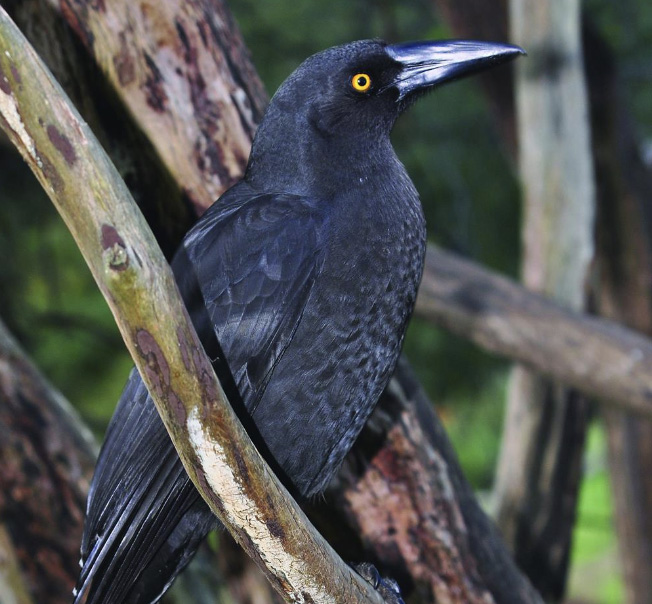
Tasmanian Native Hen
Much less attention-grabbing than their stealthy black and wedge-tailed neighbours, the Tasmanian Native Hen goes about its business quietly around Cradle Mountain. Striking and lovable in their own, approachable way, these endemic rails resemble forms of swamp hen such as the New Zealand Pukeko. They can often be seen prodding cautiously through the undergrowth around Ronny Creek, in particular.
Where to see wildlife at Cradle Mountain
The Cradle Mountain-Lake St Clair National Park covers a lot of wilderness. So, while all this wildlife can be found within the national park, it’s good to know a few places to look.
Here are some of the best places for spotting wildlife at Cradle Mountain:
Devils @ Cradle
An absolute highlight of any Cradle Mountain holiday in itself, this fabulous conservation centre and visitor attraction is a must for any wildlife lovers planning a Cradle Mountain trip. As well as being the only surefire way of seeing Tasmanian Devils at Cradle Mountain, you can also learn about them (and other endangered local wildlife) from the rangers and conservationists who work directly with them every day.
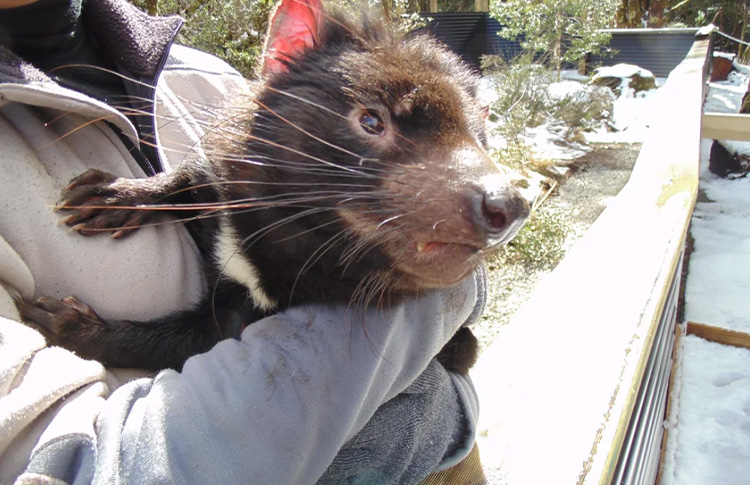
Ronny Creek
Just a few miles from the Cradle Mountain Visitor Centre, Ronny Creek is like the Times Square of hangout spots for Tasmanian wildlife, with many species often sighted here. It’s also a great starting point for wildlife walks into the park, both short and long.
Dove Lake
Another easily accessible wildlife-spotting area inside Cradle Mountain National Park, Dove Lake is a good spot to see a range of Tasmanian wildlife. In particular, it is known as the best place for seeing echidnas. Some of the best Cradle Mountain wildlife walks and hiking trails circle Dove Lake, too.
Wombat Pool
No prizes for guessing how this gets its name, as you will regularly see wombats waddling around and doing their digging here. Keep an eye out for other wildlife, though, as there’s plenty of other species who visit or make a home around this replenishing pool.
Platypus Bay
By far the most elusive and unpredictable of Cradle Mountain wildlife creatures, it makes sense that the platypus requires a bit more effort – and luck – to see. The best opportunity for spotting platypus is at the aptly named Platypus Bay, in the southern section of the Cradle Mountain-Lake St Clair National Park (much closer to Lake St Clair than the Cradle Mountain Visitor Centre entrance).
Peppers Cradle Mountain Lodge
If you want to take the “armchair approach” to spotting wildlife in Cradle Mountain, then there are few better spots to set up than the deck behind the shop at Cradle Mountain Lodge. From here, overlooking grasslands and forest at the entrance to the National Park, you can often spot a range of Tasmanian wildlife. Wallabies, pademelons and wombats are all regular visitors.
Planning your Cradle Mountain wildlife experience
Want to see all this wildlife up close? Take a look at First Light Travel’s range of Tasmanian self-drive tour itineraries that include wildlife experiences at Cradle Mountain. There’s also a dedicated Tasmania travel blog that can answer any other questions or queries you might have about travelling in Tasmania. If you want to create your own customised Cradle Mountain itinerary, just contact FLT’s Tasmanian travel experts and they can get the ball rolling!
Recent Posts
Blog Categories
Blog archives
- April 2024 (2)
- March 2024 (13)
- February 2024 (3)
- January 2024 (5)
- December 2023 (6)
- November 2023 (4)
- October 2023 (11)
- September 2023 (2)
- August 2023 (6)
- July 2023 (2)
- June 2023 (17)
- May 2023 (3)
- April 2023 (5)
- March 2023 (8)
- February 2023 (9)
- January 2023 (12)
- December 2022 (9)
- November 2022 (12)
- October 2022 (12)
- September 2022 (12)
- August 2022 (6)
- July 2022 (9)
- June 2022 (7)
- May 2022 (3)
- April 2022 (4)
- March 2022 (6)
- February 2022 (1)
- January 2022 (4)
- December 2021 (2)
- November 2021 (3)
- October 2021 (1)
- September 2021 (4)
- August 2021 (10)
- July 2021 (13)
- June 2021 (6)
- April 2021 (2)
- March 2021 (2)
- February 2021 (1)
- January 2021 (1)
- December 2020 (2)
- November 2020 (3)
- October 2020 (2)
- September 2020 (1)
- August 2020 (1)
- July 2020 (1)
- June 2020 (1)
- May 2020 (1)
- April 2020 (1)
- March 2020 (1)
- February 2020 (2)
- January 2020 (4)
- December 2019 (2)
- November 2019 (1)
- October 2019 (1)
- September 2019 (5)
- August 2019 (1)
- July 2019 (5)
- June 2019 (1)
- May 2019 (1)
- April 2019 (1)
- March 2019 (1)
- February 2019 (1)
- January 2019 (1)
- December 2018 (1)
- October 2018 (1)
- May 2018 (1)
- February 2018 (1)
- December 2017 (1)
- October 2017 (1)
- June 2017 (1)
- May 2017 (1)
- February 2017 (1)
- January 2017 (1)
- September 2016 (1)
- August 2016 (2)
- July 2016 (1)
- June 2016 (1)
- May 2016 (1)
- April 2016 (1)
- December 2015 (1)

